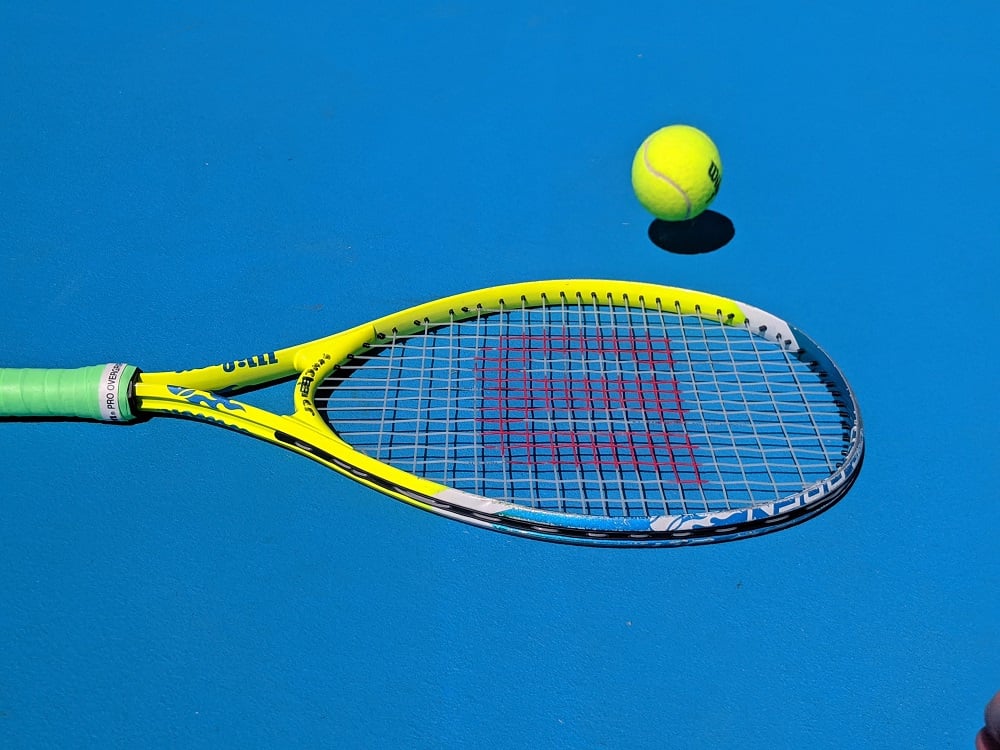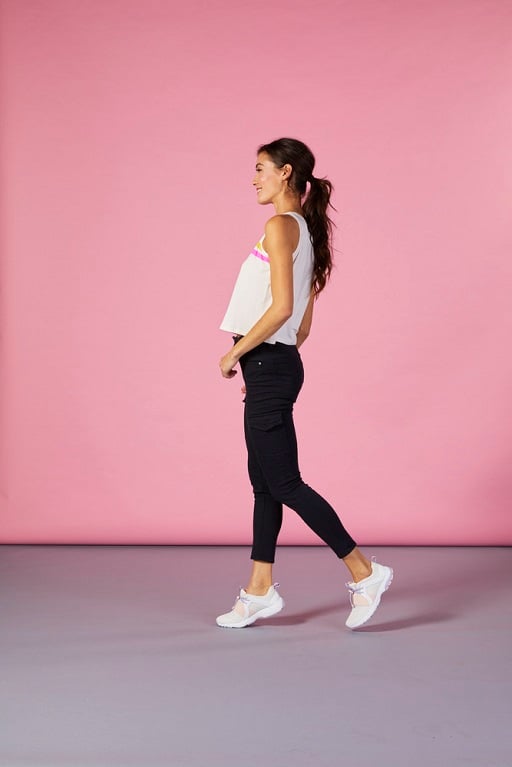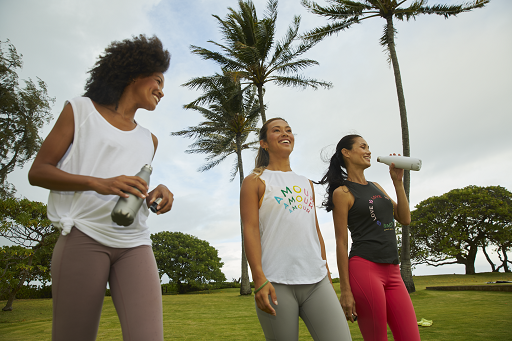
Picture yourself playing a heated tennis match. The sweat drips into your eyes and you wipe it with the back of your hand. The ball sails toward you and you shuttle sideways to crush it back over the net with your racket.
Blink, and picture yourself running instead. The sweat is still in your eyes, your legs are burning, and you can see your stopping point in the distance. Each step forward that you take gets you closer to the end of your run.
So what’s the variation between these two scenarios? If you answered “the direction of your movement,” you’re correct. Tennis players move laterally while runners move forward. This is also a key difference between tennis shoes and running shoes. When looking for tennis shoes, lateral stability and lateral support should be at the forefront. Each athletic shoe is built to support the type of movement you perform when doing the activity. Tennis shoes and running shoes are both pillars of the sneaker trend. From walking shoes for women and men to slip on sneakers, these athletic shoes paved the way for many trends today. Let’s jump into some other features of these athletic shoes.
Tennis Shoes 101
As sports medicine has developed, so too has the clothing we wear for specific sports. Instead of wearing the same athletic shoes and cotton clothing for every athletic activity, we now have specialized equipment tailored to the needs of each sport.
For tennis players, the right shoes are an important component of performance and safety.
Tennis Shoe Construction
Tennis shoes allow you to move laterally. They have features, such as:1
- Less side support – The side-to-side movements you make in tennis put you at risk of turning your ankle. If the sides of your shoes are too padded, your ankles won’t have the flexibility to move without being hampered by your shoes.
- Low profile – Tennis shoes are also made to keep you lower to the ground, allowing for better lateral movement and less space for your ankles to twist as you chase the ball.
- Heavier weight – Although tennis shoes have less cushioning than running shoes, they’re often heavier. This is due to the focus on the stability required to keep you upright on the court.
- Better grip – The outsole of tennis shoes has better gripping power so you don’t slide when you move around the court. This protects you through all of the stops and starts you must make during a match.
Tennis shoes are constructed with the intent of keeping you (and your ankles) safe on the tennis court.
Tips for Finding the Right Tennis Shoes
If you play tennis, you need tennis shoes. However, there are many different types of tennis shoes out there. Selecting the right pair for your needs requires you to consider three variables:
- The court you’re going to play tennis on
- Your style of play
- The anatomy of your foot
Let’s examine each of these factors in more detail so you know how to pick the perfect pair.
Type of Court
Yes, the specificity of tennis shoes even takes the type of court you plan to play on into account. Your playing surface impacts the amount of grip and cushioning you need. For example:2
- Clay court – Shoes made for clay-surface tennis courts have a zig-zag patterned sole to help you achieve better grip and to make cleaning clay bits from your shoes easier. Clay court shoes are also a little softer and less durable than those you’d use for a harder court.
- Hard surface – Hard courts are typically made of concrete, so playing on a hard court is tough on your shoes and your body. You’ll need shoes that offer more cushioning and durability. Heartier shoes will last longer and do a better job of protecting your joints.
- Grass – Grass can be wet and slippery, which means shoes for grass courts must have a solid grip. They also typically have a flat outsole to protect the court. The soft surface of a grass court won’t wear your shoes as quickly as a hard surface, so less cushioning is needed.
Your Playing Style
How you play tennis should also play a role in your shoe selection. If you’re typically a baseline player, you need stability for your lateral movements. Serve and volley players need more flexibility in their shoes and will want something a little lighter.
Your Foot Type
Lastly, the construction of your foot impacts the choice of shoes that’s best for keeping you on the court.
You can determine your foot type by wetting your foot and stepping on a piece of paper.3 You’ll find the imprint indicates if you’re a:
- Overpronator – If the paper shows a complete print of your foot without a defined arch, you may overpronate, or roll your foot inward when you move. Shoes with more stability are best for your feet.
- Underpronator – An over-defined arch is a sign of an underpronating foot. Instead of rolling inward with your stride, your foot rolls outward. You’ll want to invest in a more flexible shoe to allow your feet to move naturally.
- Neutral – If the imprint of your foot shows an arch that is neither too wide nor too narrow, then you likely have neutral pronation. This means your foot doesn’t roll excessively in either direction. You can probably choose any shoe appropriate for the playing surface.
As a tennis player you will also be spending your time standing on court, so we want you to find the best tennis shoes for standing all day. To do this, you should always check with a professional to ensure that you’re wearing the right shoes for you. Many sporting goods stores have staff who can help you choose the right fit.

Running Shoes 101
The main difference between tennis shoes vs running shoes is the type of movement they’re designed for.
However, if you want to start running and search for ‘running shoes’ you’ll be instantly overwhelmed by the many options out there. Running shoes are perfect for people who are on the lookout for beginner sneakers for working out. Most people opt to start with running as their first move in their fitness journey. Hence, the overwhelming number of choices.
Like tennis shoes, running shoes come suited for specific foot types, purposes, and levels of durability.
Running Shoe Anatomy
Running shoes are designed for forward movement. This means they have more ankle support and extra cushioning than tennis shoes. However, running sneakers use the same foot mechanic designations of neutral, overpronator, and underpronator.
Running shoes are divided into three categories based on these foot mechanics and what the shoes offer runners:4
- Cushioning – Shoes marketed as cushioning shoes are ideal for runners with a neutral foot. They have soft foam in the arch and heel to cushion the foot when it strikes the ground during the stride.
- Stability – Overpronators typically wear stability shoes to help support their arch when they run. The extra foam packed into the arch makes these shoes heavier than those for neutral runners.
- Motion control – Motion control shoes are designed for runners with very flat feet. These shoes have a stiffer sole and extra stabilization on the inner part of the heel. All of the extra features make these the heaviest running shoes. They’re also some of the most durable.
Why Do Runners Need Running Shoes?
If you’re a runner, the right shoes can help you prevent injuries. One study conducted by the Luxembourg Institute of Health showed a decrease in injuries in overpronating runners who wore motion-control shoes compared to those who wore neutral, cushioned shoes.5
Injuries are common in runners because running requires repetitive motions that put significant stress on your lower body. When you don’t have the correct foot support, you risk excessive strain on your legs, hips, glutes, feet, and ankles. Wearing the right shoes helps prevent some of the more common running injuries, including:6
- Plantar fasciitis
- Iliotibial (IT) band strain
- Shin splints
- Runner’s knee
- Hamstring strains
- Ankle sprains
Sliding your feet into the right running shoes is the first step to preventing injuries.
Running Shoe Shopping Tips
When you shop for running shoes, consider the following to know when you need new ones and to ensure you jog home in the perfect pair:
- Running surface – Running shoes are made for specific surfaces, just like tennis shoes. You’ll find running shoes designed for running on roads, trails, and a track. Make sure you purchase appropriate shoes for the surface (or surfaces) where you run your miles.
- Durability – If you’ve covered 350 or more miles in your old shoes, it’s time to invest in new ones.<7 The type of shoe matters—trail shoes are the heartiest, while track shoes likely won’t make it to the 350-mile mark.
- Training frequency – Shoes are expensive, so you want shoes that will last. Unfortunately, the more you wear your shoes, the more quickly they’ll wear. Marathon runners may need to replace their shoes every month or two, while casual joggers can likely go longer between purchases.
Finding the right shoe can be a daunting task. If you’re new to running or you’ve had some pesky injuries, you should visit your local running store. They can typically assess your gait and foot mechanics before making a shoe recommendation designed to meet your needs.

Comfort (and Fashion) for All Occasions at Vionic Shoes
Whether you like breaking a sweat on the courts or the trails, you need the right shoes to protect your body from injuries. At a glance, tennis shoes vs. running shoes might seem similar, but tennis shoes are designed to allow for lateral movement while running shoes cater to the repetitive forward motion of running.
After you’ve finished your athletic activities, you still need to protect your feet. At Vionic Shoes, we offer the latest styles in some of the most comfortable shoes around, including walking shoes, sandals, boots, and office-appropriate flats. From men’s tennis shoes with arch support to women’s athletic shoes, check out our amazing selection of women and men’s tennis shoes with arch support—your feet will thank you.
Sources:
- Tennis Express. Tennis Shoes 101: Everything You Need to Know. https://www.tennisexpress.com/blog/tennis-shoes-101-everything-you-need-to-know/
- All Tennis Gear. Clay Court vs. Hard Court Shoes: What’s Best for You? https://alltennisgear.com/clay-court-vs-hard-court-tennis-shoes/
- Dick’s Sporting Goods. How to Buy Tennis Shoes. https://protips.dickssportinggoods.com/sports-and-activities/racquet-sports/buying-tennis-shoes
- OrthoInfo. Athletic Shoes. https://orthoinfo.aaos.org/en/staying-healthy/athletic-shoes/
- British Journal of Sports Medicine. Injury Risk in Runners Using Standard or Motion Control Shoes. https://bjsm.bmj.com/content/50/8/481
- Yale Medicine. Running Injuries. https://www.yalemedicine.org/conditions/running-injury
- ACSM. Selecting Running Shoes. https://www.acsm.org/docs/default-source/files-for-resource-library/running-shoes.pdf?sfvrsn=6123deef_2


Leave a Reply